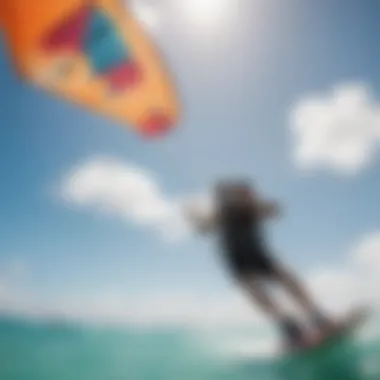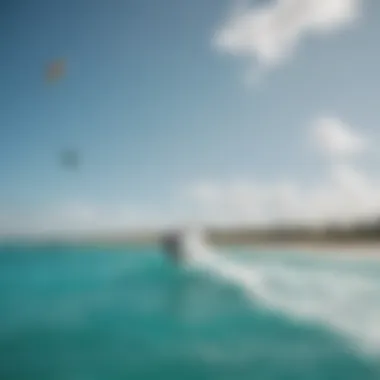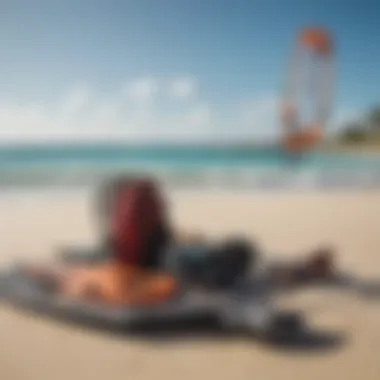Kiteboarding in Aruba: A Comprehensive Guide


Equipment Reviews
Kites
When engaging in kiteboarding, the choice of kite plays a crucial role in performance. Today’s market offers a vast array of kites, each designed with specific features to improve maneuverability and control. Understanding kite shapes, sizes, and materials is essential for optimizing your riding experience.
Kite Shapes
Kites come in different shapes such as C-shaped, bow, and delta. Each shape impacts how the kite handles during different conditions. For instance, C-shaped kites are known for their responsiveness, making them suitable for advanced tricks. Bow kites, on the other hand, offer better upwind performance and are forgiving for beginners.
Sizes and Materials
Kite sizes typically range from 3 to 20 meters, with larger kites providing more lift but requiring stronger winds. Material also matters. High-quality fabrics provide durability and efficiency. Brands like Duotone and Ozone are known for their innovative designs and were selected for their superior performance.
Boards
Selecting the right board is as important as choosing the kite. Boards generally fall into two categories: twintips and directional boards.
Twintips
Twintips are symmetrical designs suitable for both regular and goofy foot riding. They offer versatility, making them popular among recreational riders. Brands like Liquid Force and Slingshot produce robust twintips designed to handle a variety of conditions.
Directional Boards
Directional boards are shaped to ride in one direction. These are ideal for wave riding enthusiasts, providing better control on downwind sections. When picking a board, consider your riding style and the conditions you prefer. Surf-specific boards emphasize stability, whereas freestyle boards may enhance your trick capacity.
Accessories
Kiteboarding involves several essential accessories that should not be overlooked. Proper equipment ensures safety and efficiency on the water. Key accessories include harnesses, lines, pumps, and safety gear.
Harnesses
Harnesses connect the rider to the kite. Choosing a comfortable and supportive harness is vital since it shoulders the pull of the kite. Differences exist between seat and waist harnesses, each offering specific advantages based on riding style.
Safety Gear
Safety is paramount in kiteboarding. Make sure to invest in buoyancy aids, helmets, and impact vests. These items protect against potential injuries resulting from falls or collisions.
Remember that your safety and comfort largely depend on the quality of your equipment; investing wisely can greatly enhance your kiteboarding journey.
Travel Destinations
It might be worth exploring some of the best kiteboarding zones worldwide. From the inviting shimmering waters of Aruba to the windswept shores in destinations like Tarifa and Cape Town, conditions vastly vary.
Popular Spots
Some world-famous, well-equipped kiteboarding locales include the wind-rich resorts in Brazil, the cold waters of Hood River in the United States, and the paradisiacal settings of the Caribbean islands. When picking a travel destination, consider local amenities such as schools, rental options, and accommodations.
Off the Beaten Path
For those willing to explore hidden gems, lesser-known destinations can surprise any kitesurfer. Spots like a secluded bay, often missed by travelers, can deliver excellent conditions, appropriate wind directions, and unique beauty absent at overcrowded beach sites.
Techniques and Tutorials
Kiteboarding engages both beginners and experienced riders through hands-on techniques and skillful maneuvering. It is essential to understand both foundational and advanced skills to progress deeply into the sport.
Beginner Guides
Starting with effective launching, riding involves fundamentals like keeping the kite in the right zone, maintaining balance, and proper body postures. Practicing these aspects can greatly enhance the learning curve for newcomers.
Advanced Skills
More seasoned kiteboarders might focus on advanced maneuvers, like tricks that require jumping and rotation, or wave riding techniques that leverage the power of the swells. Detail-oriented practice allows you to polish skills and even develop your style over time.
Safety Guidelines
Kiteboarding is exciting, yet it necessitates strict adherence to safety rules. Riders must be keenly aware of the environmental factors that may influence their day on the water.
Weather Conditions


Understanding wind conditions can dictate successful kiteboarding. Riders should check forecasts regularly, studying tides that could impact the experience. It is crucial to adjust based on changing conditions.
Emergency Protocols
Implementing thorough emergency protocols will ensure safety even during unforeseen events. Staying alert for mishaps like dangling hooks or equipment failure is a given rather than a choice. Having a keen plan for rescue scenarios should be a common practice among seasoned kitesurfers.
Equipment Maintenance
Keeping equipment in prime condition goes a long way in safety assurances. Diligent checks can reduce the risk of failures. Consistent maintenance routines ensure that equipment lasts and performs well. Regular inspections for equipment, particularly safety gear, are essential for mitigations against preventable accidents.
Prelims to Kiteboarding in Aruba
Kiteboarding merges the thrill of surfing with the elegance of flying a kite. This sport draws many enthusiasts to various locations, but Aruba stands as a particularly prime destination. The island's natural beauty, coupled with ideal wind and water conditions, creates an environment conducive for both learning and practicing kiteboarding at all levels.
Understanding Kiteboarding
Kiteboarding involves riding on a board propelled by a large kite. Riders control the kite using a control bar, harnessing wind power efficiently. This interplay between rider, board, and kite forms the essence of the sport. It is not only a testament to skill but also allows for creativity and expression on the water.
The learning curves vary, making it accessible for beginners, while still offering challenges for seasoned riders looking to refine their techniques. Central to kiteboarding is the mastery over wind dynamics, understanding water conditions, and safety protocols.
Why Aruba is Ideal for Kiteboarding
Aruba is globally recognized for its superior kiteboarding conditions. Its flat, clear waters become particularly appealing to both novices and experienced riders alike. Several elements contribute to this reputation:
- Consistent Wind: The trade winds blow substantially throughout the year, ensuring that riders enjoy optimal conditions consistently.
- Ideal Weather: Temperatures generally remain pleasant, offering a comfortable climate for extensive riding sessions.
- Favorable Geography: Aruba's coastline features multiple spots that cater to different skill levels.
- Safety Hazard Management: The waters in Aruba are relatively free from obstacles, making it safer for practitioners to learn and perform tricks.
Geographical Advantages of Aruba
The geographical features of Aruba play a crucial role in establishing its reputation as a kiteboarding haven. Aruba's unique location, just 15 miles off the coast of Venezuela, positions it favorably with consistent winds, clear waters, and inviting beaches. These elements make Aruba attractive not just for experienced kiteboarders but also for novices keen on diving into the sport. Understanding these geographical advantages can significantly enhance the overall kiteboarding experience.
Wind Patterns and Conditions
Aruba enjoys regular trade winds that blow consistently throughout the year. The most favorable months for kiteboarding are from December to August when the winds reach their peak speeds between 15 to 30 knots. These ideal wind conditions create an environment where riders can enjoy both flat water and some waves, depending on their preferred location. The wind trends remain consistent, ensuring that kiteboarders can find suitable conditions nearly any day during these months.
It's important to monitor local forecasts. Frequently updated resources like NOAA and other weather websites can provide insights into current and upcoming wind conditions. Consistent performance from trades means less uncertainty for those seeking an exhilarating ride.
Water Quality and Temperature
What adds to the kiteboarding experience in Aruba is the remarkably clear water, with visibility often exceeding 20 meters. The warm temperatures, averaging around 80°F year-round, enhance comfort for those who venture into the sea. Such an environment encourages long sessions on the water without the worry of frigid temperatures.
Additionally, clear waters invite exploration. Among kiteboarders, this allows for easier navigation around shallow reefs and seabeds filled with marine life, augmenting the beauty of each outing. Safe launch options over good quality water support maneuvers and landings crucial for both training and freestyle capabilities.
Beaches and Launch Spots
Aruba boasts numerous beaches ideally suited for kiteboarding, offering various settings to meet different preferences. Here are some key launches you will experience:
- Bonaire Beach: Known for its expansive, open water area with minimal obstructions, making it an excellent spot for all skill levels.
- Bushiri Beach: A popular venue encrusted with vibrant sea life that shelters higher wind conditions ideal for advanced riders.
- Hadicurari Beach: Often busy with practice by local athletes, the beach provides straightforward advanced-launch setups ensuring safety while taking off or landing.
Each beach features unique characteristics concerning the landscape and wind behavior, allowing kiteboarders to select a location that aligns with their skill and preference.
"Wind conditions can elevate the excitement. Knowledge of these locations leads to both experience and skill development for kiteboarders."
The diverse environments each spot provides results in distinct kiteboarding sessions, foster creativity in stunt development, and enhance community ideas among the local riders. Every consideration when choosing your beach establishes itself as a crucial part of kiteboarding in Aruba.
The Best Kiteboarding Locations in Aruba
Selecting the right location for kiteboarding is crucial for any enthusiast, from beginners to experts. Aruba offers several beaches that are enviable in many aspects. The environment not only maximizes fun but also safety. Ideal spots take into account wind conditions, water clarity, and ease of access. These factors allow kiteboarders to focus on improving their skills or enjoying their passion with minimum distractions. Each location in Aruba comes with unique features. Knowing them can help you choose the best beach that suits your level and style.
Bonaire Beach
Bonaire Beach stands out as one of Aruba's gems for kiteboarding. This beach is well-known for its consistent wind conditions throughout the year, making it a favored choice among riders. The wind generally blows at a steady 15 to 25 knots, appropriate for most skill levels. The shallow waters make it beginner-friendly while offering excellent progress opportunities.
In addition to suitable wind, Bonaire Beach boasts stunning scenery and clear water that attract many kiteboarders. This natural beauty enhances the overall experience, making it more enjoyable to spend a day on the water. Riders can also find facilities such as showers and rental kiosks nearby, though it's wise to check availability before arriving.
Bushiri Beach
Bushiri Beach is another top choice for kiteboarding within Aruba. Its strategic location provides consistent winds similar to Bonaire but adds a more relaxed atmosphere. Less crowded, it creates a perfect setting for those looking to hone their training without feeling overwhelmed by many people.
The shallow waters and a spacious area for launching make it accessibility a crucial factor. The beach is also surrounded by picturesque views that enhance the environment for any water sports lover. Opportunities for socializing exist as well, with various spots close by where enthusiasts can gather after a day on the water. Activities extend to sunset oil offshore as wind conditions quiet down.
Hadicurari Beach


Hadicurari Beach rounds off the best locations for kiteboarding in Aruba. Despite being smaller than the other two mentioned spots, it offers high-quality experiences, particularly for skilled kiteboarders. The challenging waves and unpredictable winds make it a clash for more advanced riders seeking excitement.
Furthermore, diverse wave setups lend a hand to skill development, giving riders opportunities to learn and execute new maneuvers. Local clubs often use Hadicurari Beach for hosting friendly competitions, which naturally attracts a still enthusiastic crowd. With bars and lounges lining the backdrop, riders can unwind while discussing their performances or learning from one another, blended into a retreat from the vigor of sport.
Unique attributes of Aruba kiteboarding locations: consistent winds, safe environments, accessibility for various skill levels.
Equipment Considerations for Kiteboarding
Understanding the right equipment consideration is essential to both safety and performance in kiteboarding. Various elements shape the kiting experience, such as wind conditions, individual skill levels, and specific preferences. Having the appropriate gear can make the difference between an enjoyable session on the water and a frustrating experience. Therefore, making informed decisions about equipment is crucial for both amateurs and seasoned kitesurfers.
Choosing the Right Kite
Selecting the right kite may depend primarily on the wind conditions and your personal skill levels. Kites come in different shapes and sizes, each serving unique functions:
- C-kites: They offer high performance and increased power, suitalbe for experienced riders.
- Bow kites: Renowned for their wind range, making them ideal for beginners and multi-skilled kitesurfers.
- Hybrid kites: Provide a balance between power and stability, gripping popularity among general users.
Think about the material and construction of the kite as well. Many modern kites are built to be durable yet lightweight, enhancing performance with every pull. Knowing your body weight and the anticipated wind speed also plays a role. A well-matched kite can help you control your ride better, offering an effecient lift and reducing burnout.
Board Selection
The board selection greatly affext your agility and speed out on the water. Sizing of your board links with your riding style, mostly determined by shaping, material, and construction. Boards vary largely, including:
- Directional boards: Great for downwind riding and wave riding for skilled kiteboarders.
- Twin-tip boards: These are more common, offering versatility for beginners.
- Foil boards: A novel experience, allowing knick-knack riding above water for export kiteboarders.
The thickness, width, and fins also material negatively influence ride performance. A few inches can change not only your speed but also stability. Paying close attention to your selection can lead to much-improved sessions.
Safety Gear Essentials
When kiteboarding, considering safety gear is not sermially bound to looks, it largely decreases potential injury risks. Key safety items include:
- Helmet: Protects your head in the case of unexpected falls or collisions with equipment.
- Impact vest or buoyancy device: Reduces body shocks in rough waters, which is especially relevant in pressure zones.
- Knife: Handy for emergencies to cut lines or get yourself freed in unwanted situations.
Other excellent extras can include a life jacket or a first-aid kit, which ensures you have an all-leveled protective gear. But the need of language of headsets depends on your balancing level; we recommend enhancing your security capability before trying severe maneuvers.
Choosing the right equipment ultimately smooths your experience in kiteboarding, allowing you to focus more on the fun than on nagging safety concerns.
Kiteboarding Techniques for All Levels
Understanding kiteboarding techniques is essential for anyone looking to enhance their skills. Kiteboarding integrates various elements like balance, coordination, strength, and technique. Each level of skill has distinct challenges and joys. Without mastering these skills, progression can be frustrating and slow.
Beginner Techniques
For those new to kiteboarding, beginning with the basics is critical. Stability and control are the goals. The first essential step is to learn how to control the kite on land. Practicing is possible with a trainer kite to understand movements and reactions. A few key beginner techniques include:
- Kite Control: Master basic flying techniques. Understand how the wind direction affects the kite's movements.
- Starting: Learn to start from the beach. The focus is on positioning the kite and utilizing body mechanics to get on the board comfortably.
- Body Dragging: This technique helps to get familiar with the water. Weather conditions, like water and wind speed, play a role here. It improves confidence in handling the kite while moving through water.
Over time, learners build muscle memory and gain better kite control. Each successful session leads to more comfort on the board.
Intermediate Skills
Once initial techniques become second nature, kiteboarders can explore intermediate skills. Refinement of movements comes into play. Focus shifts towards making riding more fluid and controlled. Important illustrations of intermediate skills are:
- Navigating Turns: Transitioning from one direction to another requires smooth control. The technique incorporates edging the board, proper weight shifting, and kite movements. This enhances overall riding efficiency.
- Upwind Riding: Learning to ride upwind is essential. Being able to maneuver against the wind opens up exploration options along various beaches. Familiarize yourself with the body posture and kite angle necessary for this.
- Jumping Techniques: Beginner jumps lead into more dynamic moves. Initiating a jump while learning to land correctly and control kite positioning ensures a smooth aesthetic.
Improving strength and flexibility through exercises off the water plays a significant role here as well.
Advanced Maneuvers
Advanced kiteboarding maneuvering allows experienced kiteboarders to showcase skill with technical tricks. Mastery over kite and board craft leads to impressive performances. Some of those techniques include:
- Unhooked Riding: This involves separating from the harness. It offers intricate movement opportunities but requires deep understanding of track of control for safety.
- Complex Jumps: Incorporating spins, flips, or grabs while airborne creates unique excitement. Each comes with its trickery, thus necessitating practice and consistency.
- Wave Riding: Riding waves offers both thrill and challenge. Understanding timing can help surfers ride the swell efficiently. Mastery also demands navigating the changing conditions of sea and wind.
Throughout these levels, the role of practice can’t be ignored. As each kiteboarder progresses, engaging with more skilled peers enhances the learning journey.
In kiteboarding, continual learning transcends simple lessons. It bubbles into rich experiences powered by shared passion.
Learning kiteboarding techniques, from beginner to advanced, empowers enthusiasts to take each outing confidently. Enhancing abilities gradually paves the roadmap towards becoming a versatile kiteboarder able to thrive in Aruba's enticing waters.
Safety Guidelines for Kiteboarding


Safety is paramount in any extreme sport, and kiteboarding is no exception. Understanding the safety guidelines is crucial for both beginners and experienced kiteboarders. This section covers specific elements that enhance safety, offering benefits and critical considerations. Adhering to these guidelines not only secures individuals but also promotes a supportive community in Aruba.
Recognizing Weather Conditions
Familiarity with weather patterns is essential for any kiteboarder. The wind can vary significantly, affecting kite control and safety. It is important to check the local weather forecast regularly, considering various factors such as wind speed and direction. As a responsible kiteboarder, watch for any rapid changes in conditions like rising storm clouds or increasing wind speed.
- Look for places that offer weather updates. Websites and apps often provide real-time wind maps, crucial for planning.
- Consult local kitesurf schools for advice on suitable times for kiteboarding.
- Understanding your kite's limitations is equally important. Not all kites perform well under high wind conditions.
Maintaining awareness can prevent dangerous situations and ensure a safe kiteboarding experience.
Kiteboarding Etiquette
Kiteboarding etiquette is about respect for others and the environment. This is essential to foster a supportive kiteboarding community. Here are basic guidelines:
- Right of Way: If you are upwind of another boarder, you have the right to go forward unimpeded. Make sure to pay attention to who is downstream of you to avoid collisions.
- Launching and Landing: Always give space when others are launching or landing their kites. Communicate efficiently with fellow riders to avoid accidents.
- Keep it Clean: Support nature by cleaning up after yourself. Dispose of trash properly to protect Aruba’s beautiful beaches.
- Respect for Locals: Ensure to ask locals about the best practices. Knowing cultural norms among the kiteboarding community will aid in tying bonds and fostering a harmonious environment.
Following etiquette strengthens the kiteboarding culture in Aruba and elevates experiences for everyone involved.
Emergency Procedures
Despite planning, emergencies can occur. Thus, being prepared is essential. Familiarize yourself with the following emergency procedures:
- Personal Floatation Devices (PFDs): Wear a compliant and comfortable PFD during kiteboarding activities.
- Know Your Isolation Point: Understand initial isolation points between you and others who may assist in an emergency. It’s critical to communicate other rides’ possible locations and involve them if needed.
- First Aid Training: Acquiring basic first aid knowledge can make significant differences in emergencies. Basic life support skills could be the key to helping you and others effectively.
- Your Approach: Keep clear mental instructions for various unpredictable scenarios. Practicing what you would do ensures preparation and proper responses to various situations.
In emergencies, calmness is vital. Assess the situation objectively and act quickly to ensure safety.
Following these emergency procedures can save lives and ensure that kiteboarding remains an enjoyable activity for everyone.
Local Kiteboarding Community and Culture
The local kiteboarding community and culture in Aruba plays a pivotal role in enhancing the overall experience for both enthusiasts and newcomers. It shapes not only the interaction among the kiteboarders but also influences the atmosphere that surrounds the sport on the island. This aspect of kiteboarding fosters a sense of belonging and encourages individuals to explore their abilities and passions in a supportive environment.
Events and Competitions
Events and competitions are integral to Aruba’s kiteboarding landscape. They serve as a platform where riders from different skills levels can showcase their talents and engage with one another. Exemple of renowned annual events include the Aruba Kiteboarding Regatta. This tournament brings together local kiteboarders and international competitors. Participating in such events allows riders to experience high-energy environments that encourage improvement and skill development.
Besides the thrill of competition, events facilitate social interaction. Riders often form strong bonds, regardless of their skill level, around shared interests. The mutual support allows friends and acquaintances to cheer one another on, creating an infectious vibrancy in Aruba’s beautiful kiteboarding scene.
Clubs and Organizations
Clubs and organizations contribute significantly to the development of kiteboarding in Aruba. They provide structured guidance, coaching, and resources for all participants in the sport. For instance, the Aruba Kiteboarding Club acts as a central hub for kiteboarders, offering programs to both newcomers and seasoned veterans. It ensures that members are updated on safety practices, gear maintenance, and local laws.
Being part of a club can also offer valuable networking opportunities, facilitating friendships and mentorship relationships. Collaborating through organized activities creates bonds that go beyond the sport, enriching both personal and community life.
Learning Opportunities
Learning opportunities abound in Aruba, supporting every level of kiteboarder from novice to expert. Local schools and instructors provide detailed courses that cover the essentials to advanced maneuvers. Ensuring they follow accredited standards, schools like the Kiteboarding Aruba School offer lessons that incorporate both theory and practice in safe environments.
Additionally, workshops sometimes promote skill enhancements led by experienced riders and industry professionals. They address various techniques, from trick progressions to safety protocols. With tailored learning experiences, the community thrives, steadily cultivating new talent and preserving the sport's heritage on the island.
Engaging with the community fosters progress in skills as individuals learn from each other and add to the fabric of the vibrant kiteboarding culture in Aruba.
Ending: The Future of Kiteboarding in Aruba
The future of kiteboarding in Aruba hinges on a few significant factors. Tectonic shifts in the realms of environmental sustainability and the sport's popularity will shape how this exhilarating activity thrives here. As a sought-after destination, Aruba must contend with maintaining its appeal while ensuring minimal ecological disruption. The well-being of local ecosystems will be central to safeguarding this stunning locale for future generations.
Environmental Sustainability
Aruba's environmental sustainability efforts play a crucial role in the future of kiteboarding. The increasing number of riders attracts attention to the need for protecting marine and coastal ecosystems. Regulators are called to implement responsible practices that limit damage to coral reefs and nesting turtles. Educational programs aim at raising awareness among both locals and tourists, highlighting the importance of judicious use of resources. Recognizing the interconnectedness of wind and water health means maintaining consistent zones for kiteboarding that do not impede other wildlife.
- Collaborations between local organizations and kiteboarding schools can foster training on environmentally friendly practices.
- Regulations that restrict activities during certain seasons can help protect sensitive areas.
- Users are encouraged to select equipment made from sustainable materials, promoting a greener future for the sport.
Ultimately, managing human impact will influence Aruba's image as an eco-conscious kiteboarding haven.
Growing Popularity and Trends
Kiteboarding's current trajectory suggests increasing popularity and dynamic trends that could define its future in Aruba. An influx of tourists continuously arrives, fueled by extensive advertising and social media showcasing Aruba's pristine conditions. Events, competitions, and community gatherings cultivate an engaging atmosphere, allowing enthusiasts to connect and revel in their shared passion.
Parallely, advancements in equipment technology enhance performance and accessibility. Kites and boards are becoming lighter, more durable, and user-friendly, welcoming newcomers to the sport without diminishing the thrill for seasoned kiteboarders. The rise of, for instance, foil kiteboarding demonstrates this trend.
Key factors helping propel the sport include:
- Social Media Influence: Platforms like Instagram and Facebook present the sport visually, encouraging widespread participation.
- Local Events: Hosting competitions can spotlight Aruba on the global stage, drawing attention from elite riders and spectators alike.
- Collaboration with Tourism Agencies: By teaming up, kiteboarding schools and resorts can capitalize on Aruba’s strengths, offering targeted packages for visitors.
As these trends prevail, both the local economic impact and participation rates in kiteboarding are set to rise.
In summary, the future of kiteboarding in Aruba appears promising and desirable, yet it requires a concerted effort to marry environmental responsibility with an ever-growing and diverse community.







